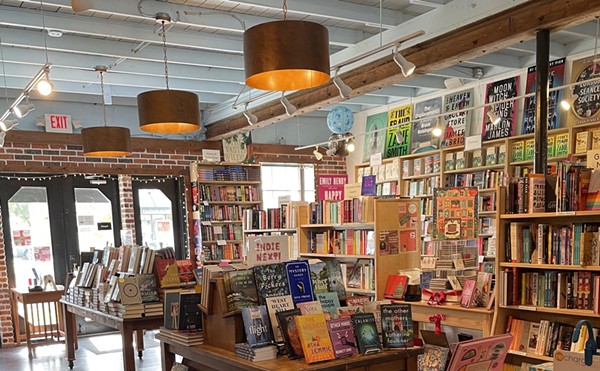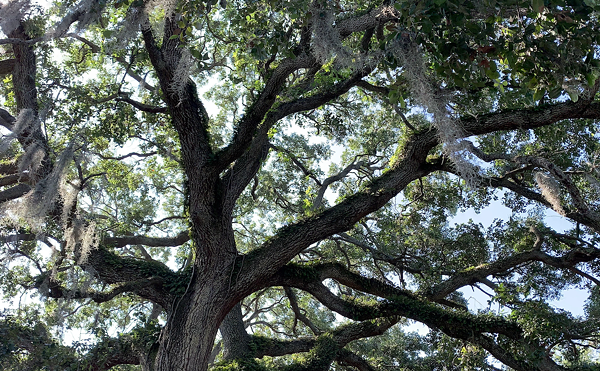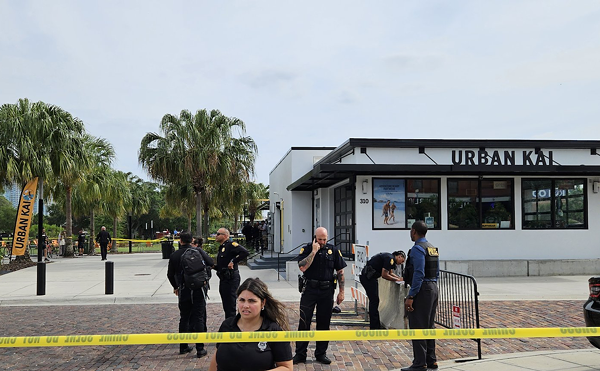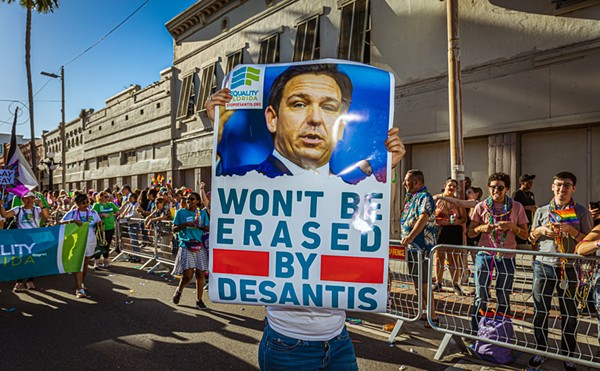With perhaps two-dozen residents of the Plant City Convalescent Home arrayed around the dining room in various states of wheelchair-bound repose, a diminutive, gray-haired fellow is standing by a karaoke rig singing "Lay Your Head on My Pillow." Crooked in his arm like a football is a poodle named Topsy. This is precisely the kind of scene that Bud Lee, picturemaker, would have to photograph. Kitschy, whimsical, Fellini-esque. I can just see him stopping in his tracks, pointing his compact 40-year-old Leica camera, and clicking away.
But Bud can't do that. Having suffered a stroke in August, 2003 - it happened at Popeye's in Plant City, amid a Weekly Planet Best of the Bay shoot - Bud Lee, 64, is paralyzed on his left side, blind in his left eye, confined to a wheelchair.
He wants out of this place. Bad. But for the foreseeable future this is his home. Bud thrives on visitors, and lately there have been lots. His first solo show draws near. From April 17 to July 10, the Tampa Museum of Art presents Bud Lee: PictureMaker, a career retrospective of 60 photographs, selected by curator Jill Jiminez from 500 submitted by Bud's agent, Sergio Waksman. The images come from Life, Esquire, Rolling Stone, Town & Country, the New York Times Magazine and other high-profile publications.
"I thought it was important to get different periods of his career," Jiminez says. "Start with some earlier pieces and move on to the big Esquire projects, with celebrities. The emphasis is on portraits; that's his strong suit. His humor and irony come into play."
Bud's latest period is best represented in the Weekly Planet. Enlisted by former editor Susan Edwards, he began shooting mostly cover features in 1998. Bud took pictures of porn stars, down-and-outers and people's closets, bringing a previously unseen artistry to the Planet's photos.
He also made quite an impression in our Ybor City offices. Bud would amble into the editorial suite, coaxing his bulky frame along, a towel usually draped around his neck. He'd tell stories and ask questions in his high-pitched purr of a voice. He was relentlessly inquisitive. He didn't always seem dialed in when an editor laid out the assignment, and he didn't always come back with what we expected. But, invariably, his work was full of personality and, at its best, revealed bare truths.
Bud looked at every assignment as an adventure - even ones that, in light of his illustrious career, could've seemed insignificant. He knew no caution. In his mind, everyone wanted their picture taken. He could take a cantankerous street person and turn him into an amateur Heidi Klum. "I could get people to pose in ways that you'd think they wouldn't want to do," Bud says. "I've been told I'm a very disarming person. That's part of it. I'm not afraid of people, not shy. I want them to look at the shoot as a collaboration."
His wife Peggy Lee adds, "He's a very kind man, very open and inclusive. At the same time, I've learned over the years that he has a way of getting what he wants with all that. That's part of what makes him very good at photographing people."
Charles Todd Lee Jr. - he's been called Bud all his life - grew up in tony Scarsdale, N.Y., the son of a career diplomat. He joined the army in the early '60s and trained as a photo lab technician. Stationed in Germany, he worked his way into shooting for military publications. Bud mustered out in early '67 and within a few months was shooting for photo-intensive Life magazine. He lived in Manhattan, but constant assignments for an array of periodicals made him a globetrotter.
He joined the federal Artists-in-Schools program, winding up in Tampa in '76. At a Plant City school where he was assigned, he met teacher Peggy Lee Laseter. They married in Ybor City, and moved into a storefront on Seventh Avenue, downstairs from a hooker named Black Mary.
Bud and Peggy Lee became the nexus of Tampa's underground arts scene, which spawned the wide open and wildly successful Artists & Writers Ball, a precursor to Guavaween and Tropical Heatwave.
Despite his free-spiritedness, Bud always wanted a brood of kids. By the time Thomas was born, the family had relocated to Davis Islands, and when the twins, Parker and Steckley came, the Lees moved out to Plant City, where they had Charlotte, the youngest.
Parker, who is working on his masters in architecture in New York, said growing up with an unconventional dad didn't seem weird. "He instilled in us that if you want to do something, do it," Parker says. "Don't let someone else tell you you can't do it."
These days, Bud Lee spends most of his days either in bed or roaming around the nursing home in his wheelchair. He occasionally sits down at an easel and paints, and he did get out and snap a few shots at the Strawberry Festival.
But his rehab has not gone as well as hoped, Peggy Lee says. Where a few years ago he might've waxed poetic when talking about one of his photographs, he now offers up clipped impressions peppered with long pauses. He doesn't smile much. Is it because of the stroke or is he just down? My guess is that it's a combination of both.
During one of my visits for this story, I asked The Dumb Question: "So how does it feel to have your first solo show?"
Bud leveled a gaze at me. "Ah, it sucks big time."
His lips crooked into a coy smile. A snapshot of the old Bud.
 1965: Bud won Military Photographer of the Year in 1966 for this shot that ran in Spearhead, the newspaper of the 3rd Armored Division. The picture, a standard shot of soldiers in training, was totally staged: Bud, who was working as a photographer and photo lab tech on an Army base in Germany, posed the GIs and plastered the soldier with mud and straw. “I got the idea from a fashion magazine,” he says. “Hiro was one of my favorite photographers. He used to do extreme close-ups of faces yelling.” Later a communist newspaper in Italy presented it as a photo taken in Vietnam, accompanying a story with an anti-war slant. “I still feel guilty about winning the award for that shot,” he says. “It won out over guys who were being shot and killed. [This picture] had nothing to do with reality.”
1965: Bud won Military Photographer of the Year in 1966 for this shot that ran in Spearhead, the newspaper of the 3rd Armored Division. The picture, a standard shot of soldiers in training, was totally staged: Bud, who was working as a photographer and photo lab tech on an Army base in Germany, posed the GIs and plastered the soldier with mud and straw. “I got the idea from a fashion magazine,” he says. “Hiro was one of my favorite photographers. He used to do extreme close-ups of faces yelling.” Later a communist newspaper in Italy presented it as a photo taken in Vietnam, accompanying a story with an anti-war slant. “I still feel guilty about winning the award for that shot,” he says. “It won out over guys who were being shot and killed. [This picture] had nothing to do with reality.”
 1967: These shots capture Bud’s first major assignments for Life magazine. He and writer Dale Wittner were dispatched to Newark (they rode down in a limo) for one of the most serious urban riots of the ’60s. The cover photo (right) is of a 12-year-old boy who got hit by the spray of a shotgun during a police pursuit of a looter. The boy survived. “Me and Dale were talking to these young black guys,” Bud explains. “It was very hot, so one of them went in to get beer for all of us. The building had already been looted. That’s when the cops showed up. They yelled, ‘Stop!’ but the [older] kid panicked and ran and they shot and killed him. It was very sad. We ended up visiting the [12-year-old] in the hospital and went to see his parents at their house.”
1967: These shots capture Bud’s first major assignments for Life magazine. He and writer Dale Wittner were dispatched to Newark (they rode down in a limo) for one of the most serious urban riots of the ’60s. The cover photo (right) is of a 12-year-old boy who got hit by the spray of a shotgun during a police pursuit of a looter. The boy survived. “Me and Dale were talking to these young black guys,” Bud explains. “It was very hot, so one of them went in to get beer for all of us. The building had already been looted. That’s when the cops showed up. They yelled, ‘Stop!’ but the [older] kid panicked and ran and they shot and killed him. It was very sad. We ended up visiting the [12-year-old] in the hospital and went to see his parents at their house.”
 A week later, Bud found himself in another riot zone: Detroit. He took the above photo of a bread line on the outskirts of the violence. At first, it looks as if the woman is crying, but a closer examination shows the young girl in the lower left corner covering her face as well, prompting the theory that they were hiding their identities because they didn’t want to be seen on a bread line. Bud can’t recall the exact circumstances, but loves the photo’s emotional power.
A week later, Bud found himself in another riot zone: Detroit. He took the above photo of a bread line on the outskirts of the violence. At first, it looks as if the woman is crying, but a closer examination shows the young girl in the lower left corner covering her face as well, prompting the theory that they were hiding their identities because they didn’t want to be seen on a bread line. Bud can’t recall the exact circumstances, but loves the photo’s emotional power.
 1965: “They used to laugh at me ’cause I was always sent to do one thing and would always come back with something else,” Bud says of his editors at the military paper Stars and Stripes. The museum shot (far left) was one such serendipitous moment. “They wanted me to shoot things that were other than military,” he explains. “I just happened to be at the Louvre. It’s a very famous painting by Rembrandt. It’s a surreal scene. It’s a picture of women through the centuries — the Rembrandt, the nuns; the girl in the miniskirt was a guide at the museum. It was a candid shot, [using] available light. They never knew they were photographed.”
1965: “They used to laugh at me ’cause I was always sent to do one thing and would always come back with something else,” Bud says of his editors at the military paper Stars and Stripes. The museum shot (far left) was one such serendipitous moment. “They wanted me to shoot things that were other than military,” he explains. “I just happened to be at the Louvre. It’s a very famous painting by Rembrandt. It’s a surreal scene. It’s a picture of women through the centuries — the Rembrandt, the nuns; the girl in the miniskirt was a guide at the museum. It was a candid shot, [using] available light. They never knew they were photographed.”
 1968: Tennessee Williams wrote a piece about Key West for Esquire, which assigned Bud as photographer. He met this woman (left) while she was working in a bar and convinced her to come back to an apartment and pose. She was game. “It didn’t take much to get her clothes off, no,” Bud says wryly. (She was wearing shorts, by the way.) He put pillows on the bottom of a bathtub to raise the woman up, filled it with water and threw in oranges and lemons from a nearby tree — dirt, stems and all. “Her breasts were like the oranges,” Bud says. He stood on the rim of the bathtub and shot a roll with his Leica; her blissed-out facial expression is almost as important to the shot as her breasts. “I think we gave her $40,” he adds. “Afterward, she got up, put her clothes on and went home. I never got her name — I wish I had — never saw her before or since.”
1968: Tennessee Williams wrote a piece about Key West for Esquire, which assigned Bud as photographer. He met this woman (left) while she was working in a bar and convinced her to come back to an apartment and pose. She was game. “It didn’t take much to get her clothes off, no,” Bud says wryly. (She was wearing shorts, by the way.) He put pillows on the bottom of a bathtub to raise the woman up, filled it with water and threw in oranges and lemons from a nearby tree — dirt, stems and all. “Her breasts were like the oranges,” Bud says. He stood on the rim of the bathtub and shot a roll with his Leica; her blissed-out facial expression is almost as important to the shot as her breasts. “I think we gave her $40,” he adds. “Afterward, she got up, put her clothes on and went home. I never got her name — I wish I had — never saw her before or since.”
 1976: This never-before-published photo was taken during Independence Day festivities in New York. It was shot from the sand infill next to the Twin Towers. “What I like about it is that people literally set up tents and made shelters out of cardboard boxes,” Bud says. “It was raining that day. I think they were tourists waiting for the tall ships to come in, but they looked like homeless people.” The infill area is now called Battery Park City, covered with green space and expensive real estate.
1976: This never-before-published photo was taken during Independence Day festivities in New York. It was shot from the sand infill next to the Twin Towers. “What I like about it is that people literally set up tents and made shelters out of cardboard boxes,” Bud says. “It was raining that day. I think they were tourists waiting for the tall ships to come in, but they looked like homeless people.” The infill area is now called Battery Park City, covered with green space and expensive real estate.

 1971: Bud shot album covers for London Records, including these two portraits for Al Green’s most popular LP, Let’s Stay Together. The photographer went with Green to his hometown in Arkansas for the shoot. The version that made the cover is below. At right is an outtake, with Green nude in a cotton field, holding a fur coat. “I urged them to use that one,” Bud says. “But [the label] thought that photo was too racy for the cover.”
1971: Bud shot album covers for London Records, including these two portraits for Al Green’s most popular LP, Let’s Stay Together. The photographer went with Green to his hometown in Arkansas for the shoot. The version that made the cover is below. At right is an outtake, with Green nude in a cotton field, holding a fur coat. “I urged them to use that one,” Bud says. “But [the label] thought that photo was too racy for the cover.”
 1971: For an Esquire piece on old movie cowboys, Bud shot the original Lone Ranger, Clayton Moore. When Bud arrived at Moore’s Los Angeles home, the Lone Ranger opened the door in full regalia and stayed that way throughout the shoot. “It was just me and him,” Bud recalls. “I didn’t set it up; I just followed him around and shot wherever he wanted to go. It’s very ’70s — the wallpaper, the puppy dog portrait, the pink carpet. He drew his gun spontaneously. He was very serious about the pose. It shows him as very vulnerable, very desperate for attention. I liked him a lot, but I felt sorry for him.”
1971: For an Esquire piece on old movie cowboys, Bud shot the original Lone Ranger, Clayton Moore. When Bud arrived at Moore’s Los Angeles home, the Lone Ranger opened the door in full regalia and stayed that way throughout the shoot. “It was just me and him,” Bud recalls. “I didn’t set it up; I just followed him around and shot wherever he wanted to go. It’s very ’70s — the wallpaper, the puppy dog portrait, the pink carpet. He drew his gun spontaneously. He was very serious about the pose. It shows him as very vulnerable, very desperate for attention. I liked him a lot, but I felt sorry for him.”
 1999: A photo from Bud’s Weekly Planet period, and one he’s particularly fond of. It accompanied a piece about a freak show in Riverview. “That’s Melvin Burkhart, the Human Blockhead; he’s dead now,” Bud explains. “He has pantyhose over his face. He had a deviated septum, which enabled him to actually do that with the nail. I had my two daughters with me. He loved freaking out people.”
1999: A photo from Bud’s Weekly Planet period, and one he’s particularly fond of. It accompanied a piece about a freak show in Riverview. “That’s Melvin Burkhart, the Human Blockhead; he’s dead now,” Bud explains. “He has pantyhose over his face. He had a deviated septum, which enabled him to actually do that with the nail. I had my two daughters with me. He loved freaking out people.”
 1970: When I asked Bud about his favorite all-time shots, this one of French filmmaker François Truffaut was the first he mentioned. It accompanied an Esquire piece about great movie directors. The assignment also required him to photograph Federico Fellini and Michelangelo Antonioni; Akira Kurosawa and Ingmar Bergman were unavailable. “With Fellini, I was there for a couple of weeks; I was milking the expense account some,” Bud says. “He was shooting Satyricon at the time, or was it Clowns? Truffaut only had 20 minutes to be with me, so I only shot him for about 10. It was in his new office in Paris. He was a very sweet guy. I love the mystery and the smoke. It’s ironic: I don’t smoke but some of my favorite shots have smoking in them.”
1970: When I asked Bud about his favorite all-time shots, this one of French filmmaker François Truffaut was the first he mentioned. It accompanied an Esquire piece about great movie directors. The assignment also required him to photograph Federico Fellini and Michelangelo Antonioni; Akira Kurosawa and Ingmar Bergman were unavailable. “With Fellini, I was there for a couple of weeks; I was milking the expense account some,” Bud says. “He was shooting Satyricon at the time, or was it Clowns? Truffaut only had 20 minutes to be with me, so I only shot him for about 10. It was in his new office in Paris. He was a very sweet guy. I love the mystery and the smoke. It’s ironic: I don’t smoke but some of my favorite shots have smoking in them.”

















